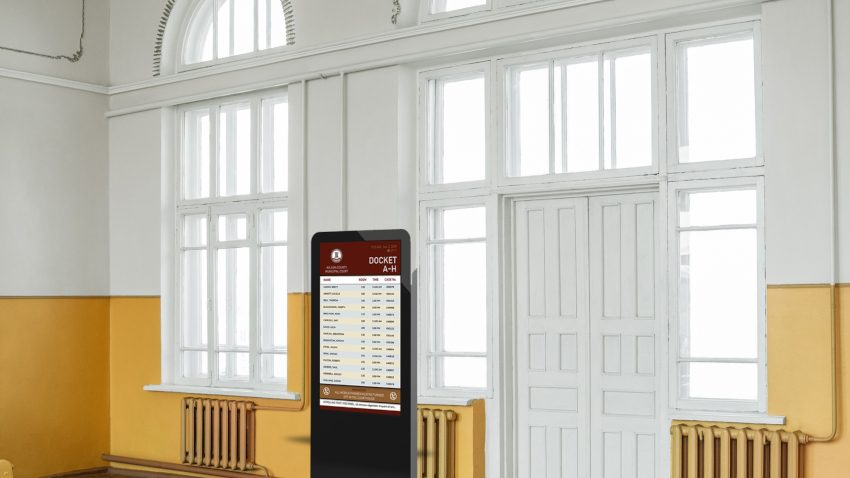Benefits of Digital Signage By Market
Many companies are replacing static displays with digital signage as the technology becomes more affordable and achievable. By 2024, the global digital signage market will hit $29.8 billion. The flexibility of digital signage is driving the technology’s growth, as nearly every industry can use digital signs.
The primary objective behind digital displays is to capture the attention of shoppers, passersby, visitors, and employees. Unlike static signage, you can update digital signs in real-time to show pertinent information. Some of the markets that benefit greatly from digital signage are as follows.

1. Healthcare
Reduced wait times are among the benefits of digital signage in healthcare facilities. The last thing sick or injured patients or worried families want to do is wait around. Fortunately, engaging content on digital signage is an entertaining distraction that reduces perceived wait times. A 30-minute wait will feel like a 15-minute wait as patients watch educational videos or facility updates. Further, waiting room digital signs alleviate anxiety among patients.
Improved wayfinding is another advantage of healthcare digital signage. Digital screens placed strategically across your facility help people get directions quickly and reduce confusion among visitors.
Additionally, digital signage simplifies internal communication with hospital staff. In particular, replace static noticeboards with digital screens to inform employees about training, events, and upcoming schedules.
Statistics
- 70% of hospitals now provide digital communication systems.
- 75% of caregivers and patients who view hospital messaging on digital signage systems say that the content enhances the hospital experience and provides helpful health information.
- 83% of patients spend a significant amount of time interacting with a hospital’s digital content.
- 27% of patients found doctors via digital messaging.
- Clinics using displays often see an increase in business between 15% and 150%.
- In fact, hospitals waste $12 billion/per year from inefficient communication.
2. Retail Stores
The ability to drive shoppers into your store is a key benefit of digital signage for retailers. Previously, retail stores relied on static images on window posters to boost foot traffic. As people become more accustomed to screens in their daily lives, they are more drawn to animated content on vibrant displays. Digital signage is more eye-catching, and it brings excited shoppers into your store.
Once customers are in the building, provide in-store entertainment via digital signs. Also, display promotions and product information to drive sales. Additionally, in-store digital displays can promote social media content from Twitter and Facebook.
Point of sale digital signage drives impulse buys by promoting low-ticket items and encouraging upsells. For instance, a clothes store can promote three-pair sock sets at the checkout line. POS digital signs also promote reward and loyalty programs by showing coupons and other perks.
Statistics
- The best live places for reaching consumers with digital signage are grocery stores (28% of American residents), shopping malls (27%), medical offices (20%), and large retail stores (20%).
- 64% of digital signage users cite increased customer engagement as the main benefit of digital signage.
- 57% also say digital signage has helped them improve customer service.
- 84% of retailers believe that digital signage creates more brand awareness compared to traditional channels.
- Digital signage creates a 46% increase in customer satisfaction.
- Digital signage bumps up the average purchase amount by 29.5%.
3. Hotels
The major benefits of digital signage in the hotel industry include improved guest experiences and advertising. Attractive video walls and digital signs at the reception and lobby impress guests and put them at ease. These screens can show weather updates and news and highlight local attractions.
At the same time, digital signs simplify navigation for your guests. For instance, digital screens in the lobby or corridors can show guests where they are and instructions to reach their destination. Additional information includes restaurant dining times and a highlight of your spa treatments.
Digital signage is an effective medium to inform guests of emergencies like storms and fires. Timely updates will put your patrons at ease as the emergency unfolds. Additionally, you can sell advertising space to local businesses and boost your revenue.
Statistics
- Digital signage has an immediate impression on the customer. It has a high impact in that 59% of those who see digital signage content want to learn more about the product or topic.
- Digital signage improves queue management and reduces perceived wait times by more than 35%.
- Digital signage raises brand awareness and complements a company’s marketing strategies. Over 40% of buyers say that digital signage can influence their purchasing decision.
4. Restaurants

Traditionally, restaurants reprinted paper menus every time there was a menu change. In addition to high printing costs, static signage also costs restaurants a lot of time. Thankfully, modern eateries can look forward to money savings with the use of digital signage.
Updating digital menu boards is effortless and quick via a content management system (CMS). If you have different menus at various times of day, set automatic schedules on the digital signage software. Furthermore, digital menu boards highlight daily specials to boost sales.
The ability to upsell menu items is another benefit of restaurant digital signage. For example, a pizza restaurant can show mouth-watering images of desserts to encourage impulse purchases. Similarly, you can promote bundles of several food items for low prices.
Restaurant digital signs help customers make more informed decisions. For instance, the screens can show allergy and nutritional information, vegan menu items, or non-dairy alternatives.
Statistics
- 74% of customers in restaurants say an effective menu display is their top priority. Digital signage allows you to create different easy-to-read menu designs without the need for reprinting.
- Indeed, they create an average increase of 3% in margin per transaction.
- Quick-service restaurants using digital menu boards account for up to 20% of the digital signage industry.
- In fact, 29.5% of restaurant customers say digital menus are more likely to influence their purchase of a product.
- Nearly 30% of customers find digital menus influential for the purchase of a product.
5. Banks
Superb customer experience is a competitive advantage for banks and financial institutions. The medium you use to update and inform clients has to be attractive and engaging.
To illustrate, a digital market wall showing dynamic content like stocks, currencies, and bonds grabs the attention of customers waiting in line. In contrast, static signage solutions are easily ignored as their content does not change.
In addition to improved customer experiences, digital signage strengthens brand loyalty. Specifically, a digital signage system harmonizes your branding materials across multiple digital screens to enhance brand awareness. Moreover, you can share reels of philanthropic events and community engagements to boost your social image.
Statistics
- Over 60% of banks use digital signage for customer communication. 75% of the messages conveyed are related to banking, while the remaining 25% are unrelated to banking.
- In fact, 95% of retail banks are satisfied with their digital signage deployment, citing that the payback period for investing in the technology can be as low as eighteen months.
- Only 21% of banks produce their digital signage content in-house. Interestingly, the rest prefer outsourcing since it is more effective.
- In fact, 70% of banks target their messaging by branch.
6. Education
One of the chief benefits of digital signs in schools is an enhanced learning experience. Today’s students use laptops and phones to text friends, play games, and interact on social media. Thus, you need equally engaging technologies to inspire students in school. Thankfully, digital signage makes learning enjoyable and keeps students alert.
Digital screens display a range of content, from audio-visual presentations, and RSS feeds to lecture recordings. What’s more, this technology is a cost-effective way to facilitate debates and discussions among students.
Another benefit of school digital signage is improved information dissemination. For example, welcome messages and wayfinding information can orient new students while employee updates simplify communication between administrators and staff. The era of crowded noticeboards is over.
Also, digital signage solutions promote safety on campuses by disseminating real-time emergency updates. For instance, alerts on digital signs can direct students and faculty to safety during a fire.
Statistics
- 73% of learning institutions see the benefits of digital signage in education as crucial for the future of communication.
- Applying technology to education helps students to reduce stress (45%), and improve confidence (46%) and efficiency (57%), while also helping students to better prepare for class (67%).
- 100% of colleges and universities with digital signage solutions use the technology for institutional news and announcements. Additionally, 86% use the technology for digital menu boards in dining facilities, while 57% use it for classroom scheduling and emergency notifications. Other common uses include wayfinding (43%), room signs (43%), and third-party advertising (14%).
- 96% of students say that video increases the learning experience.
7. Government and Corporate Offices

Many governments struggle to communicate effectively with citizens. Previously, governments ran updates on the TV or newspaper. But, consumption of traditional media is decreasing as the internet makes information more accessible. In addition to social media, governments can leverage digital signage to inform the public.
For example, digital screens in public parks display operation times, maps, rules, precautions, and historical landmarks. Similarly, digital signs at courthouses inform viewers of courtroom schedules and rules of conduct. Furthermore, digital signs in municipal buildings serve as queue management systems to enhance operations.
Corporate offices are another market that struggles to communicate with its audience, especially employees. Clear and engaging communication has a direct impact on engagement. In turn, this has a direct impact on productivity, which impacts the bottom line.
Statistics
- Indeed, 56% of internal communication teams are considering increasing the use of digital signage within their organization.
- 50% of communications professionals use digital signage as a channel.
- Digital signage helps in the workplace with employee recognition. Employees who feel appreciated are 60% more inspired to work harder.
- Digital signage improves queue management and reduces perceived wait times by more than 35%.
8. Manufacturing
Effective internal communication is extremely vital in manufacturing facilities. If you still display production metrics on noticeboards, you miss out on the multiple benefits of digital signage. To start, digital signs share real-time data on inventory management and company performance. By displaying KPIs in vibrant graphics, you keep your employee informed and engaged.
Workplace safety is another concern for manufacturing plants. Digital signs broadcast safety information and alert staff in case of gas leaks, slip hazards, machine breakdowns, and other dangerous occurrences. Consequently, you spend less on workplace accidents.
Statistics
- 93% of manufacturers use digital signage to the audience experience when displaying their products in trade shows and exhibitions.
- Nine out of ten manufacturers use digital signage solutions to reinforce employee training and increase productivity.
- In fact, digital signage improves workplace engagement by 22%, leading to 41% fewer quality defects.
- For every dollar invested in a meaningful safety solution, companies realize $4 – $6 in benefit
9. Entertainment
Print advertising is increasingly ineffective in entertainment venues as customers demand more immersive experiences. Moreover, the cutthroat competition in the industry requires players to adopt innovative solutions.
Amusement parks, sports arenas, movie theaters, casinos, and other entertainment centers enjoy improved customer engagement via digital signs. From wayfinding information, ticket promotions, upcoming events, and seating information, the possibilities are limitless with digital signage.
Dynamic presentations on digital screens have a higher recall rate compared to static signs. Therefore, digital signage presents the best opportunity to promote your brand via exciting ad campaigns. If you are looking to increase sales, sell ad space to other vendors.
Statistics
- Digital signage used in public venues has a broader reach, with up to 10% of American residents aged above 12 seeing the content as compared to 41% on Facebook or 43% on the internet.
- Visuals get 94% more views than text-based information. Interestingly, digital signage has a 47.7% effectiveness on brand awareness.
- Digital displays capture 400% more views than static displays.
- Indeed, 75% of travelers recall seeing a digital billboard within the past month.
In Conclusion

Today’s customer favors dynamic and colorful screens as the use of phones and tablets becomes more prevalent. Now is the perfect time to swap tired static posters with exciting video walls, digital menu boards, interactive kiosks, and digital billboards. The benefits of digital signage are far-reaching and include improved customer experience, safer workplaces, increased sales, and enhanced brand awareness.
Want to learn more about digital signage? Click here to read more articles on our Digital Signage Insights page!



